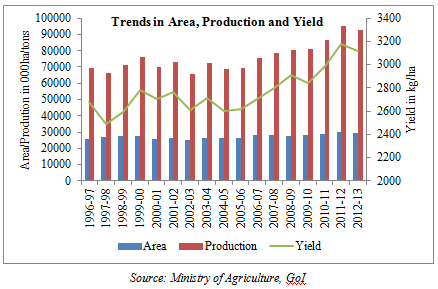|
|
Wheat |
||||||||||||||||||||||||||||||||||||||||||||||||||||||||||||||||||||||||||||||||||||||||||||||||||||||||||||||||||||||||||||||||||||
| 24 September 2014 12:43 PM | ||||||||||||||||||||||||||||||||||||||||||||||||||||||||||||||||||||||||||||||||||||||||||||||||||||||||||||||||||||||||||||||||||||
 | ||||||||||||||||||||||||||||||||||||||||||||||||||||||||||||||||||||||||||||||||||||||||||||||||||||||||||||||||||||||||||||||||||||
|
Wheat is one of the oldest crops domesticated in the world. Wheat cultivation was reported to have began in the ancient period between the Tigris and Euphrates rivers in what is today Iraq. Evidence suggests that, wheat was being used for bread in Egypt by 5000 BC and wheat cultivation had spread to Europe by 4000 BC. Domestic wheat originated in southwest Asia. Wheat cultivation in India dates back to pre-historic times.
Wheat is the third largest cereal produced in the world after corn and rice. It is more widely consumed as staple food in the world than any other cereal either in the form of bread, pasta or in any other processed form like biscuits etc.
Although a number of species of wheat recognized in the world, only three species of wheat namely; Triticum aestivum (Bread wheat)
,T. durum (Macaroni wheat) and T. dicoccum (Emmer wheat) are commercially cultivated in India.
Economically Important Product:
Wheat, like any other cereal, is grown for its carbohydrate rich seeds or endosperm.
It’s used as a staple food for almost all parts of the world in the form bread and other food preparations as well as processed foods.
Climate and Cultivation
Wheat is a major rabi cereal largely grown in the Northern parts of the country. Wheat is grown in all types of soils but well suited for well drained fertile clay loams. Wheat comes up well under sub-tropical conditions. Cool and sunny winters are highly conducive for wheat cultivation with an optimum temperature of about 20o to 25oC.
 World Scenario
Wheat is the third largest cereal produced in the world and its output has increased from about 600 million tonnes in early 2000s to about 700 million tonnes in 2013-14. Major wheat producing countries in the world include China, India, the US and Russia in the respective positions and account for about 45% of world wheat output. Although India has the largest area under wheat cultivation it is the second largest producer of wheat in the world next to China due to lower yields.
Table 1: Top 5 producers, consumers and traders of wheat in the world
Source: USDA
European Union, a group of Euro countries, is the top producer, second largest consumer and exporter. However, in terms of individual countries, China is the largest consumer followed by India, Russia and U.S. In terms of exports, U.S. has always been the top exporter of wheat contributing for nearly 1/5th of total world’s exports. However, exports from Australia have also been rising steadily from the late 2000s.
Table 2: Trends in world wheat demand and supply (million tonnes)
Source: USDA Domestic Scenario
Wheat production in the country has stagnated at around 70 million tons for over decade from mid 1990s to mid-2000s, but has started in the late 2000s steadily. The output has reached a record 95 million tons in 2011-12 though moderated slightly thereafter as per the estimates of GoI.
 Consumption of wheat also rose steadily over the past decade and reached about 90 million tonnes in 2012-13. Despite rise in consumption, India has surplus production and a comfortable level of wheat stocks. Consequently, India’s exports have also picked up momentum from 2011-12 onwards.
Table 3: Trends in domestic demand and supply of wheat (million tonnes)
Source: USDA
State-wise production
Wheat is cultivated as a rabi crop in India and majority of production comes from northern parts of India. Nearly 85% of total wheat production comes from five states. Uttar Pradesh is the largest producer of wheat contributing for about 32%. Punjab accounting for about 18% followed by Haryana for about 13%, Madhya Pradesh for about 12% and Rajasthan for about 10% of total wheat output in the country.
 Major Markets
Spot Markets
Muzaffar nagar, Agra, Ambala, Panchkula, Yamunanagar, Karnal, Panipat, Ajnala, Amritsar, Ujjain, Guna, Gwalior, Sehore, Sagar, Indore, Bhopal, Kota, Alwar, Jaipur, Sriganganagar, Dausa, Hanumangarh, Sikar, Baran, Bundi, Bharatpur.
Futures Markets
Domestic: NMCE, NCDEX and MCX.
International: CBOT/CME
External Trade
Wheat being an essential commodity, its external trade is largely monitored by the government. Nevertheless, wheat exports have increased significantly since 2011-12 and continued in the subsequent years.
Major export destinations: UAE, Yemen, Bangladesh, Thailand, Oman, Djibouti
Major import sources: Australia and Russia
Factors Influencing Prices
|
Copyright © CC Commodity Info Services LLP. All rights reserved.

